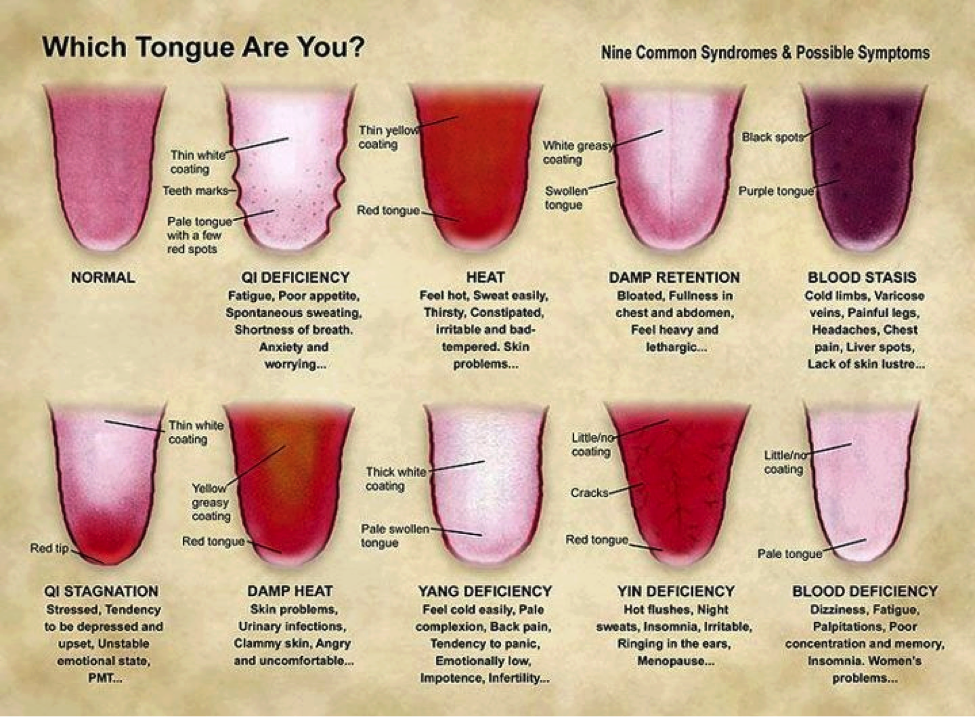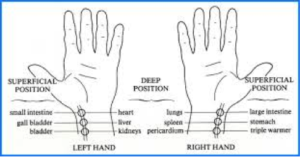
Tongue Diagnosis: The tongue is the only muscle in the body we can see that isn’t covered with skin. When an Oriental Medicine practitioner looks at the tongue they are looking at its length, overall size (e.g., swollen or not), shape (e.g., cracked, teeth marks or not), color, amount of saliva, and any details about the coat fur on top of it.
In traditional Chinese medicine, The tongue is further devised in sections and relates to the meridians and organ systems throughout the body. This creates a picture of what is happening within the body by location, nature, severity, and allows the practitioner to monitor the progression of treatment.
From a Western viewpoint, the tongue tells us how a person is digesting, how their lymphatic system functions, the quality of blood circulating in the body, neurological function, the presence of yeast or other growths in the body, and any longstanding or constitutional conditions.
It is an unfortunate fact that few people have a normal tongue once they hit their mid-twenties.
Understanding your Tongue
A normal tongue should be pink with a low amount of clear saliva, no cracks in the body, neither swollen nor atrophied, absent of any sores, and with a thin white coating on top.
If you’re interested in checking out your own tongue, the best time to do it is right after waking and before brushing your teeth or taking your morning coffee.
If you notice something strange with your tongue it is time to make an appointment even if you have no real symptoms or diagnosis. Although your tongue can vary day to day and with acute or chronic illness or injury; Changes in the tongue can also predate any serious medical issues. Your oriental medicine practitioner will educate you regarding your health and tongue with your exam so you can learn how to monitor your own health.
Tongue diagnosis is an involved process and there are volumes of books dedicated to this art. Provided below is a drawing of some of the more common tongue presentations and possible signs & symptoms (not limited to):

Pulse Diagnosis: In Western medicine, your doctor or nurse feels your pulse to determine its rate. However, in oriental medicine, pulse diagnosis is far more complicated.
In traditional Chinese medicine, the quality of your pulse can offer a great deal of information about your overall health. Chinese pulse reading is complicated because there are almost thirty different kinds of pulses–many of which are really hard to distinguish from one another. Despite being really complicated, here are a few simple guidelines that can offer some insight:

Rate. As mentioned above, when you go to your doctor’s office, they take your pulse to measure the beats per minute, or pulse rate. This is also the case in Chinese medicine, but your pulse rate is usually measured in relation to your rate of breathing. In general, a normal pulse rate is four to five beats per breath (inhalation and exhalation). A pulse that’s markedly faster usually indicates some kind of heat in your body. A pulse that’s slower indicates a cold condition, or an abundance of a cold pathogen, like dampness or phlegm. Heat is related to a condition of excess in the body and cold is a condition of deficiency in the body.
Depth. Have you ever tried to feel someone’s pulse and had a hard time finding it? Chances are you were struggling because that person had a deep pulse. The level at which your pulse is felt offers some important clues as to the location and nature of your imbalance and symptoms. A pulse that is felt deeply–meaning that you have to apply pressure to feel it–indicates that the cause of your symptoms are deep in your body, and your organs are probably affected.
When your pulse is easily felt without using much pressure, and it disappears when more pressure is applied, then your pulse is considered to be floating, or right on the surface. This means that any pattern affecting you is very superficial in nature–such as a cold or the flu. The next time someone you know gets the flu, ask to feel his or her pulse; it will likely be floating.
Force. The nature of your energy, or Qi, can be determined by the force of your pulse. A pulse that feels weak or forceless is a common indicator of a Qi or Blood depletion. A soggy pulse is one which is felt easily but feels spread out and soft. It may also indicate a Qi or Blood depletion, or, in many cases, dampness (poor water metabolism). An extremely thin or fine pulse also points to a depletion.
In contrast, a full, lively pulse that’s felt easily indicates a healthy abundance of energy. It’s possible, however, to have too much of a good thing. A pulse that feels wiry or extremely tight, like a guitar string, is common in someone who’s experiencing severe pain or someone who is under a lot of stress or has had an emotional upset.
With a pulse diagnosis, it’s the combination of factors that reveals the most information. Your oriental medicine practitioner will take into account the rate, depth, quality, and differences among the various positions in reaching any conclusions from your pulse. In TCM, these positions relate to the meridians and organ systems of the body giving further information regarding the location, nature, and severity of the imbalance and serves as a tool to measure the progression of treatment.

